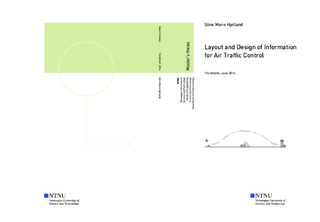| dc.description.abstract | Background
Cumulonimbus clouds (Cb) are one of the major hazards in aviation (Ahlstrom and Jaggard, 2010), but avoiding these dangerous clouds can be challenging. The Air Traffic Controllers (ATCO) have control over different airspaces and directs planes through these areas, affected by other planes and weather conditions. As clouds and their movements are difficult to predict or see exact on radars, warning pilots in advance can sometimes be challenging. ATCOs are often informed of Cbs by pilots who can see the clouds approaching. Together with Avinor and Edda Systems, IFE is working on the project ALMAR (A Large-scale Management of Air traffic control Research) to make aviation more efficient and safe, with the aim of using interaction design as a big part of this improvement.
Objectives
The aim of this thesis was to develop new information design for ATC, making it easier for ATCOs to perceive and understand relevant information about Cumulonimbus clouds, without demanding unnecessary attention, in Edda System s graphical user interface (GUI).
The Process
This master s thesis has had a user-centered approach in the development of weather graphic. Users have contributed through semi-structural interviews, focus group and touchstone tours as well as being objects of observations and test participants during the development process. As the user group is small and less accessible it became necessary to focus on qualitative data instead of quantitative, to make the most out of the few meetings and the users met. Empirical insight was combined with litterature to create a more holistic understanding of the ATC-world. Further, this was combined with theory on human factors and visual information in order to ensure necessary safety measures. Combining UCD with previous research has been emphasized throughout the project in order to accommodate possible safety measures in ATC environment, the user needs and create theoretical justifications. Thus, the theoretical part is recognized as decisive to this project.
Result
Field work and research describes Norwegian ATCO s work situation and needs. The thesis shows that limitations in the accuracy of weather information is seen as the biggest challenge in displaying weather information. However, it is questioned whether the existing display of weather information will be less suitable if technology improves. Further, the difference between Edda Systems and the current graphical user-interface (GUI) is evaluated. As the GUIs are almost inverted in base color it is found necessary to develop a solution concentrating on Edda Systems GUI, but with the aim of a generic solution. The design brief is focused around the communication of relevant information as well as the uncertainty of it. Acquiring the correct level of attention is emphasized in order to prevent creating dangerous situations by attracting focus to less important information. Additionally, making the solution adaptable to technological improvement is emphasized enabling development in coherence with the technology. The result is a proposed solution for graphical presentation of Cb in the Edda Systems GUI, that visualizes uncertainty and two levels of weather intensity. An interactive prototype was developed to illustrate the emerging of the graphic in the system, and the solution tested in an ATC-simulator in cooperation with IFE.
Delivery
Through a user-centered approach, this thesis provides thorough insight and analysis of Norwegian air traffic controllers weather information. A proposed solution for graphical presentation of Cumulonimbus in Edda Systems software, including an interactive prototype illustrating the animation of the solution. Further, two concepts are proposed to illustrate possible future upgrades in correlation with technological improvements.
Master thesis report
Attachment 1: Final solution in environment and statically illustrating animation. Digital and printed.
Attachment 2: Digital prototype illustrating animation.
Attachment 3: Two possible concepts based on future technological development. Digital and printed. | |
